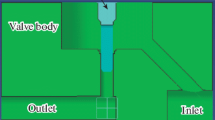Abstract
Cavitation bubble collapse has a great influence on the temperature of hydraulic oil. Herein, cone-type throttle valve experiments are carried out to study the thermodynamic processes of cavitation. First, the processes of growth and collapse are analysed, and the relationships between the hydraulic oil temperature and bubble growth and collapse are deduced. The effect of temperature is then considered on the hydraulic oil viscosity and saturated vapour pressure. Additionally, an improved form of the Rayleigh–Plesset equation is developed. The effect of cavitation on the hydraulic oil temperature is experimentally studied and the effects of cavitation bubble collapse in the hydraulic system are summarised. Using the cone-type throttle valve as an example, a method to suppress cavitation is proposed.
Similar content being viewed by others
References
DING Hai-bo, VISSER F C, JIANG Y, FURMANCZYK M. Demonstration and validation of a 3D CFD simulation tool predicting pump performance and cavitation for industrial applications [J]. Journal of Fluids Engineering, 2011, 133(1): 11101–11114.
SHEN Wei, MAI Yun-fei, SU Xiao-yu, ZHAO Jin-bao, JIANG Ji-hai. A new electric hydraulic actuator adopted the variable displacement pump[J]. Asian Journal of Control, 2016,18(1): 178–191.
LIND S, PHILLIPS T. Bubble collapse in compressible fluids using a spectral element marker particle method. Part 2. Viscoelastic fluids [J]. International Journal for Numerical Methods in Fluids, 2013, 71(9): 1103–1130.
MEROUANI S, HAMDAOUI O, REZGUI Y, GUEMINI M. Energy analysis during acoustic bubble oscillations: Relationship between bubble energy and sonochemical parameters [J]. Ultrasonics, 2014, 54(1): 227–232.
RAYLEIGH L. On the pressure developed in a liquid during the collapse of a spherical cavity [J]. Philosophical Magazine, 1917, 34: 94–98.
LIND S, PHILLIPS T. The influence of viscoelasticity on the collapse of cavitation bubbles near a rigid boundary [J]. Theoretical and Computational Fluid Dynamics, 2012, 26(1): 245–277.
ZHOU Jun-jie, VACCA A, CASOLI P. A novel approach for predicting the operation of external gear pumps under cavitating conditions [J]. Simulation Modelling Practice and Theory, 2014, 45: 35–49.
SINGH R, TIWARI S, MISHRA S. Cavitation erosion in hydraulic turbine components and mitigation by coatings: Current status and future needs [J]. Journal of Materials Engineering and Performance, 2011: 1–13.
SHEN Wei, JIANG Ji-hai, SU Xiao-yu, KARIMI H R. Control strategy analysis of the hydrualic hybrid excavator[J]. Journal of The Franklin Institute, 2015, 352(2):541–561.
AHN K, ANH H. Inverse double NARX fuzzy modeling for system identification [J]. Mechatronics, IEEE/ASME Transactions on, 2010, 15(1): 136–148.
XU Kai, LU Wen-qiang. Research on specific heat at constant pressure of non-equilibrium phase transitions in vapour-liquid two phase system [J]. Chinese Science Bulletin, 2007, 52(8): 875–879.
FRANC J, PELLONE C. Analysis of thermal effects in a cavitating inducer using Rayleigh equation [J]. Journal of Fluids Engineering, 2007, 129(8): 974–983.
TIAN Hong, YANG Chen. Thermophysics model influence on the first closed characteristics of the collapse final stage of cavitation bubble [J]. Journal of Chongqing University, 2011, 34(6): 51–59. (in Chinese)
RODIO M, GIORGI M, FICARELLA A. Influence of convective heat transfer modelling on the estimation of thermal effects in cryogenic cavitating flows [J]. International Journal of Heat and Mass Transfer, 2012, 55: 6538–6554.
BRENNEN C. Cavitation and bubble dynamics [M]. Oxford City: Oxford University Press, 1995.
GONCALVÈS E, PATELLA R. Numerical study of cavitating flows with thermodynamic effect [J]. Computers & Fluids, 2010, 39(1): 99–113.
GONCALVÈS E, PATELLA R. Constraints on equation of state for cavitating flows with thermodynamic effects [J]. Applied Mathematics and Computation, 2011, 217(11): 5095–5102.
RANZ W, MARSHALL W. Evaporation from drops. Part I & II [J]. Chem Eng Prog, 1952(48): 141–146.
LIND S J, PHILLIPS T N. Spherical bubble collapse in viscoelastic fluids [J]. Journal of Non-newtonian Fluid Mechanics, 2010, 165(1/2): 56–64.
MA Ji-en. Study on flow ripple and valve plate optimization of axial piston pump [D]. Hangzhou: Zhejiang University, 2009. (in Chinese)
FAN Cun-de. Hydraulic technology handbook [M]. Shenyang: Liaoning Science and Technology Press, 2004: 57–62. (in Chinese)
LOFSTEDT R, BARBER B P, PUTTERMAN S J. Toward a hydrodynamic theory of sonoluminescence [J]. Physics of Fluids: A-Fluid Dynamics, 1993, 5(11): 2911–2928.
BRADLEY P. BARBER R A H R. Defining the unknowns of sonoluminescence [J]. Physics Reports, 1997, 281: 65–143.
LAUNDER B, SPALDING D. The numerical computation of turbulent flows [J]. Computer Methods in Applied Mechanics and Engineering, 1974, 3(2): 269–289.
Author information
Authors and Affiliations
Corresponding author
Additional information
Foundation item: Projects(51505289, 51275123) supported by the National Natural Science Foundation of China
Rights and permissions
About this article
Cite this article
Shen, W., Zhang, J., Sun, Y. et al. Effect of cavitation bubble collapse on hydraulic oil temperature. J. Cent. South Univ. 23, 1657–1668 (2016). https://doi.org/10.1007/s11771-016-3220-z
Received:
Accepted:
Published:
Issue Date:
DOI: https://doi.org/10.1007/s11771-016-3220-z



